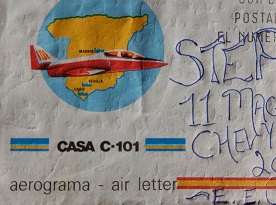In praise of old-school writing

My career as a writer started on aerogrammes, those delicate sheets of paper that ingeniously fold up to become both letter and envelope in one. Lightweight for international travel, the aerogramme provides a finite space in which to convey your news, so every word counts.
Much of my childhood was spent in Botswana. When letters arrived from the United States, I would marvel at the stamp-encrusted envelopes, AFRICA written all in caps and heavily underlined to help the post office identify the letter’s obscure destination; AIR MAIL slashed slant-wise on both sides of the address, also scored with emphatic lines.
Very rarely were the letters for me. Sometimes my grandmother would send me a note in her distinctive, almost indecipherable handwriting. Sometimes I’d get a birthday party invitation. There was a brief period when I signed up for a pen pal through the Puffin Club and had a rather dull exchange with a British girl who lived in Luton.
When we moved back to the States, I started to correspond with the friends I left behind in Botswana. “Dear Tumie, How are you? I am fine. Today I went to school. Math class was boring…” They weren’t the most thrilling missives, but they were my first serious attempts at communicating through the written word.
Gradually, through the years, I began to refine my letter-writing technique. We moved to Cairo, and I wrote long letters to my American friends. The Egyptian postal system was excruciatingly slow, and it would take months to receive a reply.
Back in America, I wrote letters to the friends made in Cairo. By then, I was so enamored of letter-writing that I wrote letters to friends who lived just a short car ride away, like my friend Suzy. She and I would send each other thick letters which included snippets of short stories: flash fiction before it was even a thing.
At school, my friends and I passed copious notes to each other. The teachers saw us with our heads bent, writing furiously, and thought we were diligent students. Or, more likely, they were just relieved we weren’t making trouble and let us get away with our little charade.
In junior high, I started to keep a diary, the naked and unvarnished id to the prettied-up superego of my letters. My journal might tell one story, my letters another. For example, I triumphantly wrote to my friend Tumie that I had received a Valentines from every single boy in my sixth-grade class. In my diary, I divulged that my teacher instructed us to give Valentines to everyone.
I spent my junior year of high school in Barcelona. Every week, I would buy a stack of aerogrammes to write to my relatives and friends. By then, I had learned to skip the how-are-yous and get straight to the news. There was lots of it, and I tried to deliver it as scintillatingly as possible. People told me they loved my letters. That praise was fuel to my long-held ambitions to be a writer.
In pursuit of that ambition, I wrote a novel and a slew of short stories while in my twenties. But then I had children and gave up writing all together, even in my journal. Some women can write, raise kids, and work a full-time job, but I am not one of them. It was to be 10 years before I wrote creatively again.
Then along came the Internet. While it may have led to the aerogramme’s precipitous decline, it made me a more prolific correspondent. With dial-up access and an AOL account, I could now keep up a real-time dialogue with friends who lived across the country while avoiding those pesky long-distance telephone fees. I’m not a phone person anyway; I much prefer to communicate via the written word.
We moved to Japan, where the Internet was quicker and my workload teaching in a high school was light, and so I began to email with a vengeance, blasting out long missives detailing our adventures and challenges as a family living abroad.
This daily exercising of my writing muscles became a habit. Soon, writing emails was not enough, and I started on a novel. I’ve been writing ever since.
I haven’t replaced private correspondence with writing meant for public consumption; I make room for both. I write daily to one friend, weekly to another, and maintain other correspondences which compensate with verbosity what they lack in frequency. With my astute and articulate epistolary partners, I exchange ideas, opinions, anecdotes, and trustworthy feedback; thoughts and phrases that appear in my dispatches will pop up later in my fiction or in this column.
Like the scales a musician warms up with, letter-writing flexes and tones my writing skills and is an indispensable part of my writing process.

